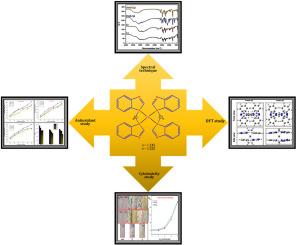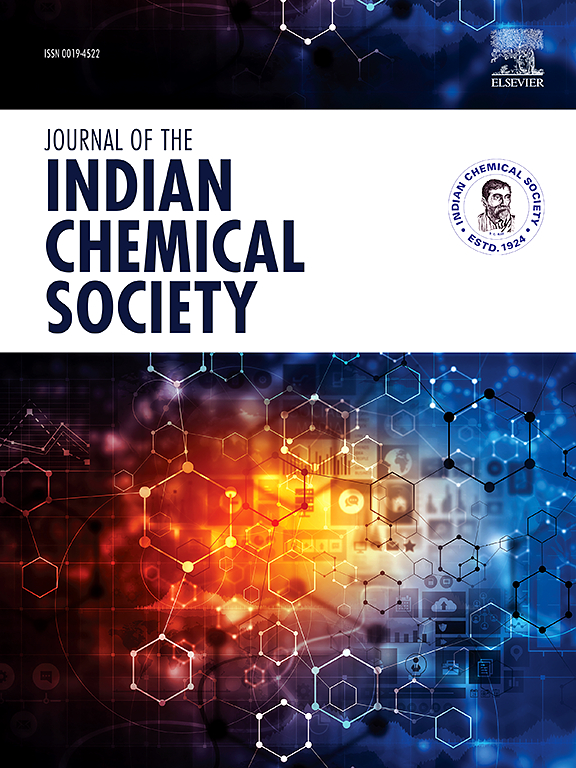Multifaceted insights into Cu(II) complexes with bis(benzimidazole) ligands: Structural investigation, theoretical studies, cytotoxicity evaluation, and antioxidant summarizing
IF 3.2
4区 化学
Q2 CHEMISTRY, MULTIDISCIPLINARY
引用次数: 0
Abstract
In this study, the synthesized two new ligands, namely bis(1H-benzo[d]imidazole-1-yl) methane [L1] and 1,2-bis(1H-benzo[d]imidazole-1-yl) ethane [L2], from benzimidazole. They chose 1,2-dibromomethane and 1,2-dibromoethane as they are widely used in environmental catalysis and as ligands in conjugated configurations. The researchers were able to synthesize the Cu(II) complexes, [Cu(L1)2]Cl2 or [1] and [Cu(L2)2]Cl2 or [2], at room temperature. They used several analytical techniques, including elemental analysis, magnetic moment measurement, UV–visible spectroscopy, FT-IR spectroscopy, FT-Raman spectroscopy, NMR spectroscopy (including 1H, 13C, DEPT-135, HSQC, and HMBC techniques), ESI-MS analysis, thermogravimetric analysis, and ESR spectroscopy, to characterize the synthesized compounds. They found that the ESR spectra of complexes [1] and [2] suggest that both metal complexes have square planar coordination spheres. In the DFT study of the geometrical optimization of both complexes, the central plane consists of the Cu metal atom connected to four nitrogen atoms. The Cu–N bond lengths are measured at 2.194 Å for [1] and 2.176 Å for [2] whereas the FMO theory's slight reduction in the HOMO-LUMO gap for [2] suggests that it is more reactive and less stable compared to [1]. In addition, the researchers tested the effect of these compounds on human cervical cancer cell lines (HeLa) which showed significant cytotoxic effects under laboratory conditions. Complex [2] had a significant inhibitory impact on the growth of cancer cells. The researchers also assessed the antioxidant effects of the ligands and metal complexes using DPPH, OH, and NO assays and found that [2] had the most potent inhibitory effect on the radicals, with IC50 values of 36.11 μM (DPPH), 28.18 μM (OH), and 26.20 μM (NO).

双(苯并咪唑)配体 Cu(II)配合物的多方面见解:结构调查、理论研究、细胞毒性评估和抗氧化总结
在这项研究中,他们从苯并咪唑中合成了两种新配体,即双(1H-苯并[d]咪唑-1-基)甲烷[L1]和 1,2-双(1H-苯并[d]咪唑-1-基)乙烷[L2]。他们之所以选择 1,2- 二溴甲烷和 1,2- 二溴乙烷,是因为它们被广泛用于环境催化和共轭构型中的配体。研究人员能够在室温下合成 Cu(II) 复合物 [Cu(L1)2]Cl2 或 [1] 和 [Cu(L2)2]Cl2 或 [2]。他们采用了多种分析技术,包括元素分析、磁矩测量、紫外-可见光谱、傅立叶变换红外光谱、傅立叶变换-拉曼光谱、核磁共振光谱(包括 1H、13C、DEPT-135、HSQC 和 HMBC 技术)、ESI-MS 分析、热重分析和 ESR 光谱,对合成的化合物进行了表征。他们发现[1]和[2]复合物的 ESR 光谱表明这两种金属复合物都具有方形平面配位球。在对这两种配合物进行几何优化的 DFT 研究中,中心平面由连接四个氮原子的铜金属原子组成。根据测量,[1] 的 Cu-N 键长度为 2.194 Å,[2] 的 Cu-N 键长度为 2.176 Å,而根据 FMO 理论,[2] 的 HOMO-LUMO 间隙略有减小,这表明与[1] 相比,[2] 的反应性更强,稳定性更差。此外,研究人员还测试了这些化合物对人类宫颈癌细胞株(HeLa)的影响,结果显示,在实验室条件下,这些化合物具有显著的细胞毒性作用。复合物 [2] 对癌细胞的生长有明显的抑制作用。研究人员还利用 DPPH、OH 和 NO 试验评估了配体和金属复合物的抗氧化作用,结果发现 [2] 对自由基的抑制作用最强,其 IC50 值分别为 36.11 μM(DPPH)、28.18 μM(OH)和 26.20 μM(NO)。
本文章由计算机程序翻译,如有差异,请以英文原文为准。
求助全文
约1分钟内获得全文
求助全文
来源期刊
CiteScore
3.50
自引率
7.70%
发文量
492
审稿时长
3-8 weeks
期刊介绍:
The Journal of the Indian Chemical Society publishes original, fundamental, theorical, experimental research work of highest quality in all areas of chemistry, biochemistry, medicinal chemistry, electrochemistry, agrochemistry, chemical engineering and technology, food chemistry, environmental chemistry, etc.

 求助内容:
求助内容: 应助结果提醒方式:
应助结果提醒方式:


